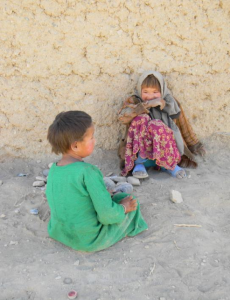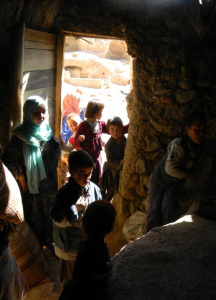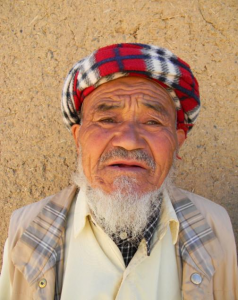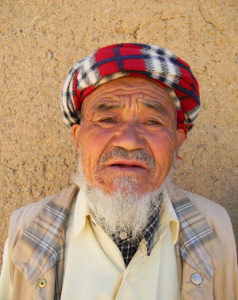Rohan O. Nazzreth from bamyan, Afghanistan describes a visit he made along with Jimmy (Dr. James. C. Dabhi), my friend, who is helping me discover these stories of a less known Afghanistan. This guest article is part of a series I am calling Afghan Life – lesser known lives and voices from Afghanistan, or the Afghanistan beyond the world’s military parking lot.
A while back three of us visited the caves along the hilly range which housed the Buddha statues. Dr. Jimmy C. Dabhi – a sociologist from India (a visiting professor at the Bamyan and Herat University), Dawlat – a local interpreter and myself. Some of the stories we heard from the families living in these caves were heart wrenching. It made me wonder how people facing so many hardships, still had the heart to offer us tea, with a smile and with a genuineness that I have not seen before.
The people living in these caves have been neglected by the government and continue to live in the most difficult of situations. Water, food, fuel and climatic conditions put these people, some of them returnee refugees in hardships which unfortunately has become a way of life for them. The 30 odd years of civil war and foreign invasions has only pushed these people and a majority of Afghans in terrible human conditions.
These are some of the stories we heard and witnessed.
Family = ‘Khonwada’ in Dari (Afghan Persian)
Khonwada 1

While trekking up the hill we noticed a little girl and her sister playing with stones. They both looked malnourished and weak, one of them with a skin disease. But they still smiled when they saw us. This is a family of 8 members. The father who was the only bread winner of the family passed away with a sickness a year back. (Life expectancy in Afghanistan for men is 44 years and for women 45 years). With him dead, the family income is a huge problem. The mother can’t work because of her children as she needs to take care of them. The only income which does come in is by the girls’ grandfather who is very old. He has a donkey. The days he has enough energy, he drags himself along with his very young grandson at midnight to the mountains to gather small bushes. These bushes are generally sold as fuel in the ‘bazaar’. This income is extremely sporadic which during the 5 month of severe winter is non existent.
Khonwada 2
A little distance away from the two girls lives another family who came to these caves around 20 years back. Previously they were living in a village of Bamyan called Akrabad where they had no land of their own and no food. When the Taliban came to power the cave where they live in currently was destroyed by the Taliban. They narrowly escaped death and fled to Iran in those years. The father is the only bread winner of the house and works as a daily wage earner, earning between 100-300 Afghanis on good days, otherwise pretty much nothing.
During the winter here with temperatures reaching -20 there is no work and no income. On asking the women if they worked, they replied in the negative as they had to take care of their many children, most of whom were below 6 years.
One of the women told us as we heard before that they had a lot of problem with water. The nearest stream which is 2.5 kms away down the steep hill is dirty and extremely unhealthy. Their children as well as themselves are exposed on a daily bases to water borne diseases.
The old woman in the photo is the grandmother of these children. “I have seen a lot of conflicts in my life, a lot of people dying. All I wish is for peace in Afghanistan first, only then can we improve our life”. The lines on her face and the near blankness in her eyes tell us this without her having to.
Khonwada 3
 This family was previously living in the Gumbaht region of Bamiyan. When the Taliban came to power they burnt their house down along with everything in it. They too narrowly escaped to Behsud. They have now been living in these caves for the past 4 years with a family of 8, of which 6 are children. The oldest is a boy – Ghulam Sakhi who is in the 7th standard and goes to the local school. During the winter the stream which is their source of water freezes. They, along with a thousand other families depend on an underground spring 3.5 kms away.
This family was previously living in the Gumbaht region of Bamiyan. When the Taliban came to power they burnt their house down along with everything in it. They too narrowly escaped to Behsud. They have now been living in these caves for the past 4 years with a family of 8, of which 6 are children. The oldest is a boy – Ghulam Sakhi who is in the 7th standard and goes to the local school. During the winter the stream which is their source of water freezes. They, along with a thousand other families depend on an underground spring 3.5 kms away.
Looking at their one room cave we asked them where they cook their food, to which they replied “Here”. Most of the houses have a Tandoor. A hole in the ground in which they bake ‘Naan’ – bread. They use bushes as fuel which fills the cave with smoke at it burns. They told us that during the winter it was the worst. “You can’t go outside because it is too cold. We just have to bear the smoke if we want to eat.”
Khonwada 4
 This family too moved to the caves from Akrabad village. They too dint have any food or work there. There were 45 families in that village some of whom left. This family has 10 members, of which 5 are girls and 3 are boys. They have been living here for the past 1 year. Their father works in a farm not owned by him and gets a share of one-fifth of the produce of the field he works in. The field is of a size of 2 Jiribs (1 Jirib=2400 square meters). They, like every other family have a lot of difficulty with water. There is of course no electricity and fuel. We asked the lady of the house if we could take her photo. She refused “If my husband finds out he will hit me”.
This family too moved to the caves from Akrabad village. They too dint have any food or work there. There were 45 families in that village some of whom left. This family has 10 members, of which 5 are girls and 3 are boys. They have been living here for the past 1 year. Their father works in a farm not owned by him and gets a share of one-fifth of the produce of the field he works in. The field is of a size of 2 Jiribs (1 Jirib=2400 square meters). They, like every other family have a lot of difficulty with water. There is of course no electricity and fuel. We asked the lady of the house if we could take her photo. She refused “If my husband finds out he will hit me”.
Almost all the families have atleast 7-8 children. I asked Dawlat that considering the widespread poverty why is it so. He told me in a very matter of fact way. “What you have seen is not the end, they will continue having children. It is because of the lack of education, absence of clinics and not being aware of family planning”.
Khonwada 5
 We met the head of the family and the oldest man in that area who is 75 years old. He told us there are 100 families around these hills. Only 30 families can get water from the tap at the local mosque. The remaining have the long trek down to the nearest stream. A few families make use of donkeys to get the water up to their families.
We met the head of the family and the oldest man in that area who is 75 years old. He told us there are 100 families around these hills. Only 30 families can get water from the tap at the local mosque. The remaining have the long trek down to the nearest stream. A few families make use of donkeys to get the water up to their families.
The 75 year old man was originally from the Yawkalong region of the Bamiyan province. He came here with his family 70 years back and lived in a cave. Now, he has been able to build himself and his family a small house of mud, straw and small stones.
During the time of the initial Taliban attack his 3 sons were in the market. They heard the Taliban were approaching and packed whatever they could to escape. While escaping the 75 year old man got shot twice, wounds which he showed me. One at the groin region and the other at the side of his knee. His family managed to rescue him and escape.
The political party called Hizbi-Wahdat (headed by Mr. Khalili) which can be considered as the political party representing the minority Hazaras, with its base in Bamyan province had reached a deal with the Junbish party (representing the Uzbeks and headed by Abdul Rashid Dustum) which is located in Mazar province. The deal was reached during the time the Taliban were entering with lightining speed through all the provinces of Afghanistan, killing ethnic minorities. The deal was that which ever province was attacked the other would send its men to fight against the Taliban. Mazar was attacked first, hence Mr. Khalili (current vice president of Afghanistan) sent around 3000 young men from Bamyan to support the Junbish forces. They were ambushed when they reached Mazar. Only 1% survived.
This old man’s son was in those 3000. “I don’t know if my son is dead or alive or in prison, I wish he comes back home”. Dawlat took me aside gently and said “His son is dead.” Makes me wonder, ‘What is man without hope?’
Khonwada 6
 The man then took us to another family of 9 members, 5 of which are girls and 2 boys. Their grandfather was murdered in the cave they are staying in now. We asked the women what was their life like –
The man then took us to another family of 9 members, 5 of which are girls and 2 boys. Their grandfather was murdered in the cave they are staying in now. We asked the women what was their life like –
“It’s a very tough life for us, but we have no choice, we are resigned to our fate”
On being asked if they would want their daughter to have a better life –
“We pray everyday that Allah grants us peace and security, especially for our daughters. We pray that they will not have to live the kind of life we have lived”.
These are just a few of innumerable stories that currently plague Afghan society. Most of them have hope that Afghanistan will improve and they will have a better life. What is a human being without hope.
Rohan O. Nazareth
Bamyan – Afghanistan
2010

yes it shows the lack of educatinon of our people and show how they can life with their family and firends i am so sorry for my governament that he cant make a better life for them. i hope one day they can get thier right.
yes it shows the lack of educatinon of our people and show how they can life with their family and firends i am so sorry for my governament that he cant make a better life for them. i hope one day they can get thier right.
yes it shows the lack of educatinon of our people and show how they can life with their family and firends i am so sorry for my governament that he cant make a better life for them. i hope one day they can get thier right.
yes it shows the lack of educatinon of our people and show how they can life with their family and firends i am so sorry for my governament that he cant make a better life for them. i hope one day they can get thier right.
lack of education, religious/social/economic influences..political climate…all contribute to the state they’re in… considering the lack of support and help that wouldn’t be forthcoming… guess their only respite is hope and their own personal faith that allows them to exist the way they do…
lack of education, religious/social/economic influences..political climate…all contribute to the state they’re in… considering the lack of support and help that wouldn’t be forthcoming… guess their only respite is hope and their own personal faith that allows them to exist the way they do…
Yes, the stories are heart-wrenching! Education …. rather lack of it is possibly one of the causes. Religious myths and selfish interpretations of religion by the influential few, further compound the situations.
Yes, the stories are heart-wrenching! Education …. rather lack of it is possibly one of the causes. Religious myths and selfish interpretations of religion by the influential few, further compound the situations.